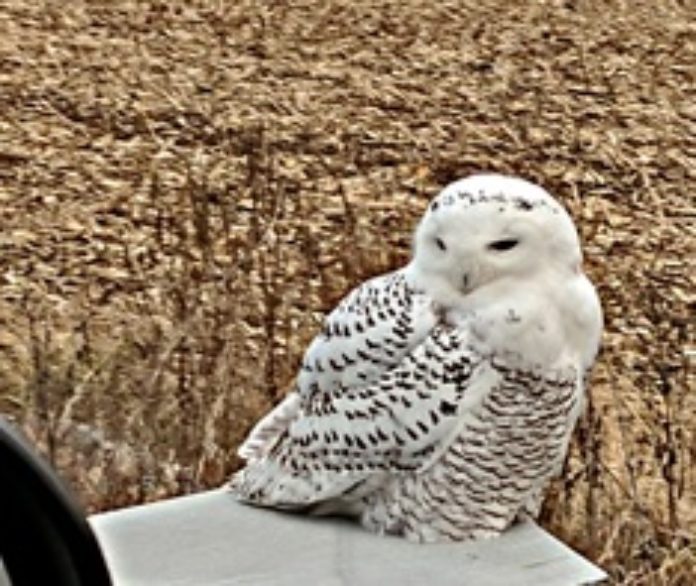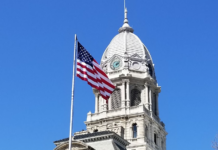A robust breeding season is setting the stage for a large influx of arctic snowy owls in northern Indiana and elsewhere.
The Times-Union received reports and photos of the northern Canadian owls in the area this week as the birds migrate for the winter season into the Great Lakes region and other parts of the United States, including the East Coast and Upper Plain.
This year’s movement appears to be quite abundant.
“If you ever wanted to see a snowy owl, this is probably the winter to do it,” said Scott Weidensaul, a director with Project SNOWStorm, a group of scientists, wildlife veterinarians and others who are studying the winter ecology of snowy owls.
While the migration season is still early, Weidensaul said he’s receiving reports that this winter will be “one of the biggest flights of snowy owls into the Great Lakes in many, many years.”
The birds’ migration from the arctic region of northern Canada have been underway for a while and led to numerous reports around the Great Lakes.
In Kosciusko County, the birds apparently started showing up in recent days.
On Monday, Ted and Mary Shoemaker, North Webster, spotted a snowy owl perched on a guardrail north of North Webster near the National Weather Service office.
On Tuesday, Roy and Darlene Anderson, Mentone, saw one perched on a utility pole about two-and-a-half miles north of Mentone along Ind. 19.
At Grace College, Jacob Mishne was headed to his dorm when he spotted one Tuesday, according to ebird.org, which documented his finding.
Snowy owls are big and powerful, weighing between 4 and 6 pounds and feature a mostly white plumage. They spend their summers in the arctic and subarctic regions and gained notoriety with many through the role of Hedwig in the Harry Potter series.
Usually, most of the snowy owls that migrate tend to be in their first year of life.
The migratory influx – or irruption, as experts say – is the result of a large breeding season spurred by lemmings – hamster-sized rodents that populate the arctic regions – and are a favorite choice of food for the owls in arctic areas, Weidensaul said.
The interaction between snowy owls and lemmings is one of the mysteries of nature.
Lemming populations tend to spike on a four-year cycle.
Somehow, the owls know where in the arctic the lemming populations are highest and then gather in those areas ahead of the breeding season.
When the owls pair up, even before the female is finished laying her eggs, the male will begin bringing in prey to the nest. In fact, four years ago, a photographer captured an image in which a male had collected 78 dead lemmings near the nest.
The dead rodents provide clear evidence that there is plenty of food to support a large brood, Weidensaul said.
As a result, instead of laying three or four eggs, they will lay as many as nine eggs, he said.
Mary Shoemaker said the owl they spotted wasn’t moving and didn’t seem to be in good health, so she and her husband talked to an employee at Syracuse Animal Hospital who suggested they contact a nearby wildlife rehabilitator, which they did.
The licensed wildlife rehabilitator, who specializes in raptors and asked not to be identified, said the bird was malnourished and dehydrated. It weighed 2 pounds and was very weak when she took it in on Monday.
She said she’s working with a veterinarian on a longterm recovery plan and it has already gained some weight.
She said the bird will be returned to the wild when it is ready – if it survives.
To report a sickly looking owl, she suggests people go to the Indiana Department of Natural Resources website by searching “Indiana DNR orphaned and injured animals.”
Weidensaul said it’s not uncommon to find a few sick owls who are migrating. Some, he said, are just not good hunters and some become sick or injured.
The owls often don’t get spooked around people – and for good reason.
“Most have never seen a human being before. They come from a part of the world where there are very few people. So it’s easy to get close to them,” Weidensaul said.
While it’s easy to get close to them, he said if they start watching you and start moving around nervously, you’re probably too close.
“We ask folks to be respectful of them,” he said.
As the owls move south, they prefer to feed on small mammals such as muskrats and rabbits and they especially like to feed on ducks.
The birds seek out terrain that looks like home, such as wide-open fields and coastlines along the Great Lakes, he said.
They often perch on the ground or on short posts. From there they patiently watch for prey.
“Sadly, they also really like airports,” Weidensaul said.
“As you can imagine, airports are dangerous places for owls and owls are dangerous to airplanes,” he said.
The owls are a protected species and it is illegal to hunt, kill or trap them, Weidensaul said.





